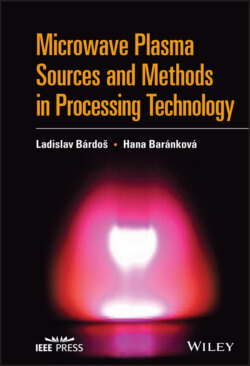Microwave Plasma Sources and Methods in Processing Technology

Реклама. ООО «ЛитРес», ИНН: 7719571260.
Оглавление
Ladislav Bardos. Microwave Plasma Sources and Methods in Processing Technology
Microwave Plasma Sources and Methods in Processing Technology
Contents
List of Figures
List of Table
Guide
Pages
Foreword from the Authors
References
1 Basic Principles and Components in the Microwave Techniques and Power Systems. 1.1 History in Brief – From Alternating Current to Electromagnetic Waves and to Microwaves
1.2 Microwave Generators
1.3 Waveguides and Electromagnetic Modes in Wave Propagation
1.3.1 The Cut-off Frequency and the Wavelength in Waveguides
1.3.2 Waveguides Filled by Dielectrics
1.3.3 Wave Impedance and Standing Waves in Waveguides
1.3.4 Coaxial Transmission Lines
1.3.5 Microwave Resonators
1.4 Waveguide Power Lines
1.4.1 Magnetron Tube Microwave Generator
1.4.2 Microwave Insulators
1.4.3 Impedance Tuners
1.4.4 Directional Couplers
1.4.5 Passive Waveguide Components – Bends, Flanges, Vacuum Windows
1.4.6 Tapered Waveguides and Waveguide Transformers
1.4.7 Power Loads and Load Tuners
1.4.8 Waveguide Phase Shifters
1.4.9 Waveguide Shorting Plungers
1.4.10 Coupling from Rectangular to Circular Waveguide: Resonant Cavities for Generation of Plasma
1.5 Microwave Oven – A Most Common Microwave Power Device
References
2 Gas Discharge Plasmas
2.1 Basic Understanding of the Gas Discharge Plasmas
2.2 Generation of the Plasma, Townsend Coefficients, Paschen Curve
2.3 Generation of the Plasma by AC Power, Plasma Frequency, Cut-off Density
2.4 Space-charge Sheaths at Different Frequencies of the Incident Power
2.5 Classification of Gas Discharge Plasmas, Effects of Gas Pressure, Microwave Generation of Plasmas. 2.5.1 Classification of Gas Discharge Plasmas
2.5.2 Effects of the Gas Pressure on Particle Collisions in the Plasma
2.5.3 Microwave Generation of Plasmas
References
3 Interactions of Plasmas with Solids and Gases
3.1 Plasma Processing, PVD, and PE CVD
3.2 Sputtering, Evaporation, Dry Etching, Cleaning, and Oxidation of Surfaces
3.3 Particle Transport in Plasma Processing and Effects of Gas Pressure
3.3.1 Movements of Neutral Particles
3.3.2 Movements of Charged Particles
3.3 Effect of the Gas Pressure on the Plasma Processing
3.4 Afterglow and Decaying Plasma Processing
References
4 Microwave Plasma Systems for Plasma Processing at Reduced Pressures
4.1 Waveguide-Generated Isotropic and Magnetoactive Microwave Plasmas
4.1.1 Waveguide-Generated Isotropic Microwave Oxygen Plasma for Silicon Oxidation
4.1.2 ECR and Higher Induction Magnetized Plasma Systems for Silicon Oxidation
4.2 PE CVD of Silicon Nitride Films in the Far Afterglow
4.3 Microwave Plasma Jets for PE CVD of Films
4.3.1 Deposition of Carbon Nitride Films
4.3.2 Surfajet Plasma Parameters and an Arrangement for Expanding the Plasma Diameter
4.4 Hybrid Microwave Plasma System with Magnetized Hollow Cathode
References
5 Microwave Plasma Systems at Atmospheric and Higher Pressures
5.1 Features of the Atmospheric Plasma and Cold Atmospheric Plasma (CAP) Sources
5.2 Atmospheric Microwave Plasma Sources Assisted by Hollow Cathodes
5.2.1 Applications of the H-HEAD Plasma Source in Surface Treatments
5.3 Microwave Treatment of Diesel Exhaust
5.4 Microwave Plasma in Liquids
5.5 Microwave Plasma Interactions with Flames
5.6 Microwave Plasmas at Very High Pressures
References
6 New Applications and Trends in the Microwave Plasmas
References
7 Appendices. 7.1 List of Symbols and Abbreviations
Chapter 2
Chapter 3
Chapter 4
Chapter 5
7.2 Constants and Numbers
Index
WILEY END USER LICENSE AGREEMENT
Отрывок из книги
Ladislav Bárdoš and Hana Baránková
Uppsala University, Uppsala, Sweden
.....
After an explanation of the functions of microwave components in the typical power lines for the microwave plasma generation, in Chapter 2, we describe the fundamentals of the gas discharge plasma and differences between plasmas generated by different kinds of the power, with particular emphasis to the microwave power. Chapter 3 is devoted to explanations of interactions of plasmas with solid surfaces and gases, mainly at reduced and low pressures. Used explanations are simplified and limited to basic expressions and equations necessary for the understanding of the processes in the plasma and those caused by the plasma, as described in later chapters. Parts of the texts and some illustrations in Chapters 2 and 3 are used in the authors’ courses for university students, short tutorials at companies and, since 1997, in annual courses for the Society of Vacuum Coaters (www.svc.org) in the United States.
Chapter 4 focuses on different microwave plasma systems, including novel and non-conventional ones developed and laboratory tested in different processing applications at reduced pressures. Chapter 5 is devoted to the microwave plasma systems at atmospheric and higher pressures, including plasmas inside liquids and plasma interactions with the combustion flames. Chapter 6 describes some new applications and trends in microwave plasmas, with short opinions and expectations on future perspectives of the microwave plasma and its applications. Chapter 7 contains appendices with description of symbols, abbreviations, units and values used in the individual chapters.
.....